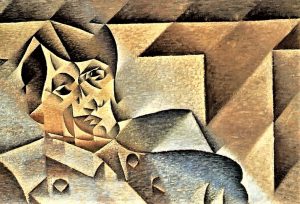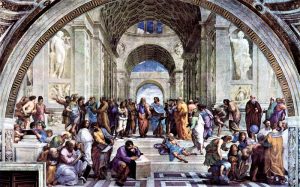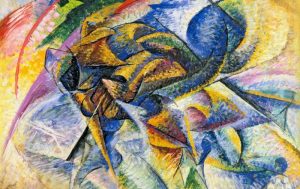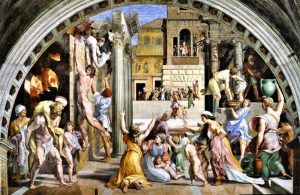Cubism
In the fine arts, the term cubism describes the revolutionary style of painting invented by Pablo Picasso and Georges Braque in Paris, during the period between 1907 and 1912. Their cubist methods, initially influenced by geometric themes in the landscape compositions of post-impressionist painter Paul Cézanne, radically redefined the nature and scope of artistic painting and, to a lesser extent, sculpture, as practiced previously, and announced a completely new style. Different ways of representing reality. Cubism marked the end of the era dominated by the Renaissance and the beginning of modern art.

Related topics
Classicism, contemporary art, Fauvism, pop art, dadaism, romanticism, op art, Post-Impressionism, suprematism
What is Cubism?
It is an artistic movement that enclosed painting, literature and sculpture and whose main objective was to move away from the naturalistic representation of things to simultaneously capture an object from different angles.
About Cubism
Cubism consists of capturing simultaneously the same object so it can be seen from different angles, this is achieved through the use of geometric figures such as triangles, squares, rectangles and cubes. Their approaches are very unpublished in the field of art.
His approaches are totally unpublished in art. He creates a new pictorial and aesthetic language that implies a new relationship between the spectator and the artwork. The spectator cannot simply contemplate the work but must reconstruct it in his mind in order to understand it. Painting is something mental, the spectator interprets the reality according to the guidelines given by the work and becomes an artist, a creator.
It also consists in separating aesthetics from the interpretation of nature, for which reason the work has value in itself, as a means of expressing ideas. It disassociates nature by means of the decomposition of the figure in its minimal parts and painted in geometric form.
Characteristics
The main characteristics of cubism are:
- It had a multiple perspective to represent the totality of the objects in the same plane.
- The color management was based on a palette of gray, green and brown colors with little light.
- The main interest of cubism was more focused on how to represent the coals.
- It begins formally with the painting The ladies of Avignon (Demoiselles D’Avignon) by Pablo Picasso.
- In its first stage, grey and ochre color prevailed.
- Cubism was weakened by the First Civil War.
- It died in 1919 when the post-war period began.
History
After three decades of impressionism, which culminated in the Fauvism colorist movement, Picasso worried that painting would be a dead end with no possibilities for intellectual exploration. In this state of mind, and recently exposed the African tribal art while in Spain, he began painting Les Demoiselles D’Avignon, an innovative masterpiece, whose chipped planes replaced the traditional linear perspective and rounded volumes thus signaling his break with the naturalistic traditions of Western art. At the same time, Georges Braque, a former student at the prestigious Ecole des Beaux-Arts in Paris, had just been overwhelmed by the 1907 Exhibition of Cézanne’s paintings at the Salon d’Automne and the Galerie Bernheim-Jeune, in particular Cézanne’s masterpiece.
In the summer of 1908, during his stay at L’Estaque, near Marseille, Braque painted a series of landscapes that were exhibited later that year in a gallery in Paris, owned by art dealer Daniel-Henri Kahnweiler. In reviewing this exhibition, the famous art critic Louis Vauxcelles commented on how Braque reduces everything, views, figures and houses, to geometric contours, to cubes. The following year, Vauxcelles used the expression cubic eccentricities, a phrase supposedly used for the first time by Henri Matisse, and in 1911 the term “Cubism” had entered the English language.
Who invented it?
Picasso has always been considered the creator of cubism. However, the truth could be different. Cubism is a term first used by the critic Louis Vauxcelles to give a disturbed perspective on an artwork. It is also believed to have emerged in Oriental and African art as there were many resources hinting at the presence of Cubism.
Where it was born?
Scholars and followers of the movement claim that Cubism was born in France and developed between 1907 and 1914. The main exponents were Pablo Picasso, Georges Braque and Juan Gris.
The origin of the name came when Braque had an exhibition in Paris in 1908, where a series of paintings had been taken. Henri Matisse was present at the exhibition and, surprised by the linear and geometric strokes of the works, began to speak of cubes.
Types of cubism
In this movement there are two distinct phases or types of cubism:
- Analytical cubism: it is also known as pure and quite complete cubism. It is based on the decomposition of geometric shapes and figures in order to make an analysis and rearrange them in a different and decomposed way.
- Synthetic cubism: it was the continuation of the analytical cubism and its bases were the re-composition of objects, they looked for the way to capture the essence of the physiognomy. They used many colors and predominant forms and it was at this stage that the collage technique emerged and the use of elements of everyday life to give a global image offering a concrete reference.
Themes of cubism
Their themes were based on elements that could not be concretized, on the substitution of feelings for humor and on joy. They used geometric figures to portray reality. The main themes are portraits and urban still life.
Cubist architecture
Cubism greatly influenced architecture. It was against architecture that was very utilitarian, materialistic, spiritual and not theoretical enough. They thought that architecture should be more poetic, expressive and full of drama.
Cubist painting
It is considered the most important pictorial expression of the movement. It originated in Paris with Pablo Picasso. It was a short but very important movement, so much so that it surpassed the contemporary styles of Europe. He looked for a way to break with the classical norms, the depth and the description of nature.
Cubist Sculpture
The cubist sculpture has the same aesthetics as the pictorial sculpture and also has the same objectives, the difference is that the cubist works in three different dimensions. The sculpture is characterized by the simultaneity of the perspectives, by the intersection of the volumes, the decomposition of the forms and the new appreciation of the materials.
Representatives
The main representatives of Cubism were:
- Pablo Ruiz Picasso: painter and sculptor of Spanish origin considered the best artist of the 20th century. He was part of many artistic movements and painted many works that today are kept in important museums around the world.
- Georges Braque: was a French painter and sculptor. He is considered one of the creators of cubism. He mainly painted still life and his works spread all over the world.
- José Victoriano González-Pérez: better known as Juan Gris, was a painter of Spanish origin with a firm structure and good rhythm, with a cubism full of colors and synthetic.
- Fernard Léger: was a French cubist painter. He was inspired by World War I and began a period known as the mechanical period in which he used symbols of the industrial world.
Works of cubism
Some of the main works within cubism are the following:
- Portrait of Picasso
- Still life with blind
- Still life with guitar, book and newspaper
- Guitar and mandolin
- Three musicians
- Guernica
- Les Demoiselles D’Avignon
How to cite this article?
Briceño V., Gabriela. (2019). Cubism. Recovered on 23 February, 2024, de Euston96: https://www.euston96.com/en/cubism/









